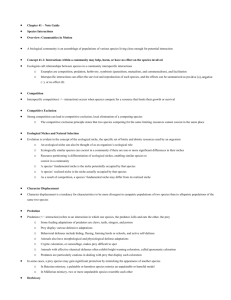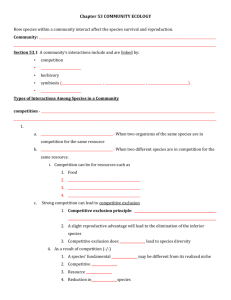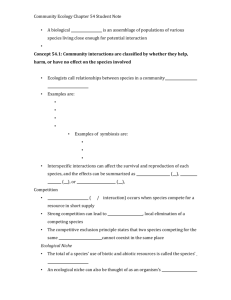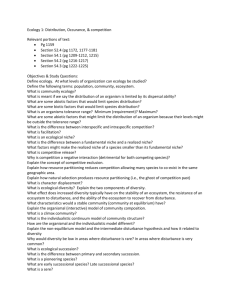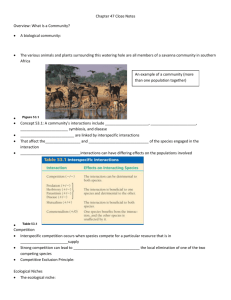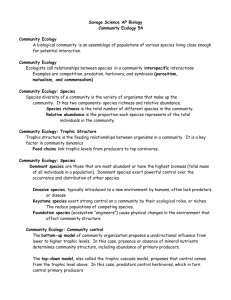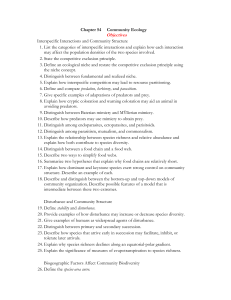Community Ecology Notes
advertisement
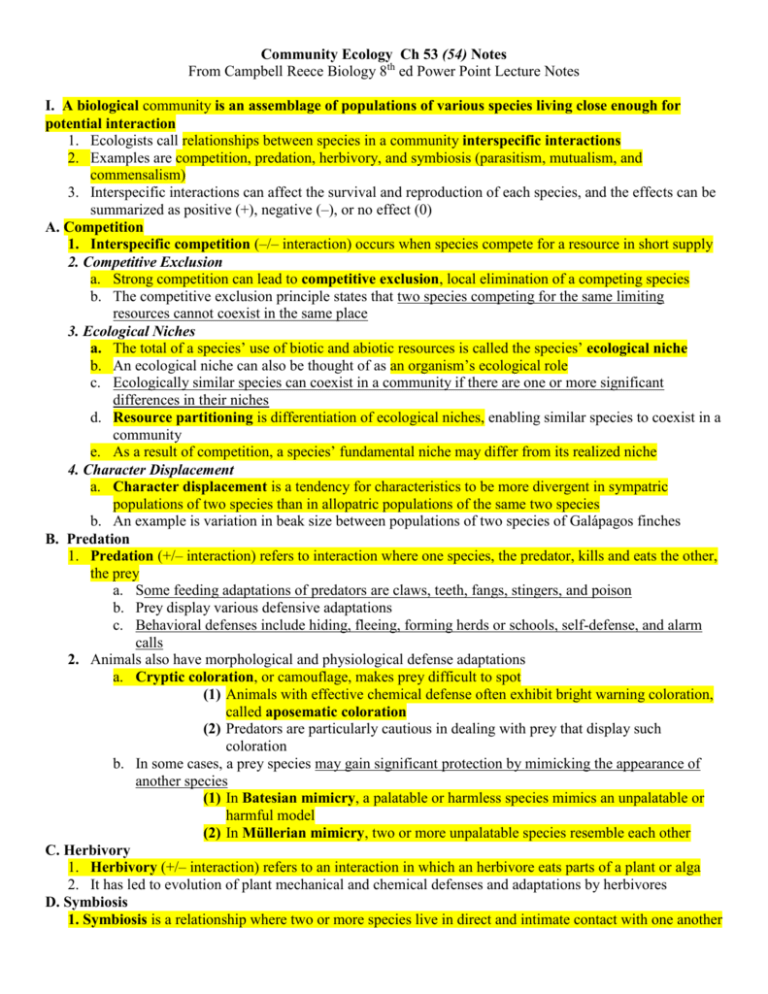
Community Ecology Ch 53 (54) Notes From Campbell Reece Biology 8th ed Power Point Lecture Notes I. A biological community is an assemblage of populations of various species living close enough for potential interaction 1. Ecologists call relationships between species in a community interspecific interactions 2. Examples are competition, predation, herbivory, and symbiosis (parasitism, mutualism, and commensalism) 3. Interspecific interactions can affect the survival and reproduction of each species, and the effects can be summarized as positive (+), negative (–), or no effect (0) A. Competition 1. Interspecific competition (–/– interaction) occurs when species compete for a resource in short supply 2. Competitive Exclusion a. Strong competition can lead to competitive exclusion, local elimination of a competing species b. The competitive exclusion principle states that two species competing for the same limiting resources cannot coexist in the same place 3. Ecological Niches a. The total of a species’ use of biotic and abiotic resources is called the species’ ecological niche b. An ecological niche can also be thought of as an organism’s ecological role c. Ecologically similar species can coexist in a community if there are one or more significant differences in their niches d. Resource partitioning is differentiation of ecological niches, enabling similar species to coexist in a community e. As a result of competition, a species’ fundamental niche may differ from its realized niche 4. Character Displacement a. Character displacement is a tendency for characteristics to be more divergent in sympatric populations of two species than in allopatric populations of the same two species b. An example is variation in beak size between populations of two species of Galápagos finches B. Predation 1. Predation (+/– interaction) refers to interaction where one species, the predator, kills and eats the other, the prey a. Some feeding adaptations of predators are claws, teeth, fangs, stingers, and poison b. Prey display various defensive adaptations c. Behavioral defenses include hiding, fleeing, forming herds or schools, self-defense, and alarm calls 2. Animals also have morphological and physiological defense adaptations a. Cryptic coloration, or camouflage, makes prey difficult to spot (1) Animals with effective chemical defense often exhibit bright warning coloration, called aposematic coloration (2) Predators are particularly cautious in dealing with prey that display such coloration b. In some cases, a prey species may gain significant protection by mimicking the appearance of another species (1) In Batesian mimicry, a palatable or harmless species mimics an unpalatable or harmful model (2) In Müllerian mimicry, two or more unpalatable species resemble each other C. Herbivory 1. Herbivory (+/– interaction) refers to an interaction in which an herbivore eats parts of a plant or alga 2. It has led to evolution of plant mechanical and chemical defenses and adaptations by herbivores D. Symbiosis 1. Symbiosis is a relationship where two or more species live in direct and intimate contact with one another 2. Parasitism a. In parasitism (+/– interaction), one organism, the parasite, derives nourishment from another organism, its host, which is harmed in the process b. Parasites that live within the body of their host are called endoparasites; parasites that live on the external surface of a host are ectoparasites c. Many parasites have a complex life cycle involving a number of hosts d. Some parasites change the behavior of the host to increase their own fitness E. Mutualism 1. Mutualistic symbiosis, or mutualism (+/+ interaction), is an interspecific interaction that benefits both species 2. A mutualism can be – Obligate, where one species cannot survive without the other – Facultative, where both species can survive alone F. Commensalism 1. In commensalism (+/0 interaction), one species benefits and the other is apparently unaffected 2. Commensal interactions are hard to document in nature because any close association likely affects both species II. Concept 54.2: Dominant and keystone species exert strong controls on community structure 1. In general, a few species in a community exert strong control on that community’s structure 2. Two fundamental features of community structure are species diversity and feeding relationships 3. Two communities can have the same species richness but a different relative abundance 4. Diversity can be compared using a diversity index • Shannon diversity index (H): H = –[(pA ln pA) + (pB ln pB) + (pC ln pC) + …] 5. Determining the number and abundance of species in a community is difficult, especially for small organisms 6. Molecular tools can be used to help determine microbial diversity A. Trophic Structure 1. Trophic structure is the feeding relationships between organisms in a community 2. It is a key factor in community dynamics 3. Food chains link trophic levels from producers to top carnivores B. Food Webs 1. A food web is a branching food chain with complex trophic interactions 2. Species may play a role at more than one trophic level 3. Food webs can be simplified by isolating a portion of a community that interacts very little with the rest of the community C. Limits on Food Chain Length 1. Each food chain in a food web is usually only a few links long 2. Two hypotheses attempt to explain food chain length: the energetic hypothesis and the dynamic stability hypothesis 3. The energetic hypothesis suggests that length is limited by inefficient energy transfer 4. The dynamic stability hypothesis proposes that long food chains are less stable than short ones 5. Most data support the energetic hypothesis D. Species with a Large Impact 1. Certain species have a very large impact on community structure 2. Such species are highly abundant or play a pivotal role in community dynamics E. Dominant Species 1. Dominant species are those that are most abundant or have the highest biomass 2. Biomass is the total mass of all individuals in a population 3. Dominant species exert powerful control over the occurrence and distribution of other species 4. One hypothesis suggests that dominant species are most competitive in exploiting resources 5. Another hypothesis is that they are most successful at avoiding predators 6. Invasive species, typically introduced to a new environment by humans, often lack predators or disease F. Keystone Species 1. Keystone species exert strong control on a community by their ecological roles, or niches 2. In contrast to dominant species, they are not necessarily abundant in a community 3. Field studies of sea stars exhibit their role as a keystone species in intertidal communities 4. Observation of sea otter populations and their predation shows how otters affect ocean communities G. Foundation Species (Ecosystem “Engineers”) • Foundation species (ecosystem “engineers”) cause physical changes in the environment that affect community structure • For example, beaver dams can transform landscapes on a very large scale • Some foundation species act as facilitators that have positive effects on survival and reproduction of some other species in the community Bottom-Up and Top-Down Controls • The bottom-up model of community organization proposes a unidirectional influence from lower to higher trophic levels • In this case, presence or absence of mineral nutrients determines community structure, including abundance of primary producers • The top-down model, also called the trophic cascade model, proposes that control comes from the trophic level above • In this case, predators control herbivores, which in turn control primary producers • Long-term experimental studies have shown that communities vary in their relative degree of bottom-up to top-down control • Pollution can affect community dynamics • Biomanipulation can help restore polluted communities Concept 54.3: Disturbance influences species diversity and composition • Decades ago, most ecologists favored the view that communities are in a state of equilibrium • This view was supported by F. E. Clements who suggested that species in a climax community function as a superorganism • Other ecologists, including A. G. Tansley and H. A. Gleason, challenged whether communities were at equilibrium • Recent evidence of change has led to a nonequilibrium model, which describes communities as constantly changing after being buffeted by disturbances Characterizing Disturbance • A disturbance is an event that changes a community, removes organisms from it, and alters resource availability • Fire is a significant disturbance in most terrestrial ecosystems • It is often a necessity in some communities • The intermediate disturbance hypothesis suggests that moderate levels of disturbance can foster greater diversity than either high or low levels of disturbance • High levels of disturbance exclude many slow-growing species • Low levels of disturbance allow dominant species to exclude less competitive species • The large-scale fire in Yellowstone National Park in 1988 demonstrated that communities can often respond very rapidly to a massive disturbance Ecological Succession • Ecological succession is the sequence of community and ecosystem changes after a disturbance • Primary succession occurs where no soil exists when succession begins • Secondary succession begins in an area where soil remains after a disturbance • Early-arriving species and later-arriving species may be linked in one of three processes: + Early arrivals may facilitate appearance of later species by making the environment favorable – They may inhibit establishment of later species 0 They may tolerate later species but have no impact on their establishment • Retreating glaciers provide a valuable field-research opportunity for observing succession • Succession on the moraines in Glacier Bay, Alaska, follows a predictable pattern of change in vegetation and soil characteristics • Succession is the result of changes induced by the vegetation itself • On the glacial moraines, vegetation lowers the soil pH and increases soil nitrogen content Human Disturbance • Humans have the greatest impact on biological communities worldwide • Human disturbance to communities usually reduces species diversity • Humans also prevent some naturally occurring disturbances, which can be important to community structure Concept 54.4: Biogeographic factors affect community biodiversity • Latitude and area are two key factors that affect a community’s species diversity Latitudinal Gradients • Species richness generally declines along an equatorial-polar gradient and is especially great in the tropics • Two key factors in equatorial-polar gradients of species richness are probably evolutionary history and climate • The greater age of tropical environments may account for the greater species richness • Climate is likely the primary cause of the latitudinal gradient in biodiversity • Two main climatic factors correlated with biodiversity are solar energy and water availability • They can be considered together by measuring a community’s rate of evapotranspiration • Evapotranspiration is evaporation of water from soil plus transpiration of water from plants Area Effects • The species-area curve quantifies the idea that, all other factors being equal, a larger geographic area has more species • A species-area curve of North American breeding birds supports this idea Island Equilibrium Model • Species richness on islands depends on island size, distance from the mainland, immigration, and extinction • The equilibrium model of island biogeography maintains that species richness on an ecological island levels off at a dynamic equilibrium point • Studies of species richness on the Galápagos Islands support the prediction that species richness increases with island size Concept 54.5: Community ecology is useful for understanding pathogen life cycles and controlling human disease • Ecological communities are universally affected by pathogens, which include disease-causing microorganisms, viruses, viroids, and prions • Pathogens can alter community structure quickly and extensively Pathogens and Community Structure • Pathogens can have dramatic effects on communities • For example, coral reef communities are being decimated by white-band disease • Human activities are transporting pathogens around the world at unprecedented rates • Community ecology is needed to help study and combat them Community Ecology and Zoonotic Diseases • Zoonotic pathogens have been transferred from other animals to humans • The transfer of pathogens can be direct or through an intermediate species called a vector • Many of today’s emerging human diseases are zoonotic • Avian flu is a highly contagious virus of birds • Ecologists are studying the potential spread of the virus from Asia to North America through migrating birds You should now be able to: 1. Distinguish between the following sets of terms: competition, predation, herbivory, symbiosis; fundamental and realized niche; cryptic and aposematic coloration; Batesian mimicry and Müllerian mimicry; parasitism, mutualism, and commensalism; endoparasites and ectoparasites; species richness and relative abundance; food chain and food web; primary and secondary succession 2. Define an ecological niche and explain the competitive exclusion principle in terms of the niche concept 3. Explain how dominant and keystone species exert strong control on community structure 4. Distinguish between bottom-up and top-down community organization 5. Describe and explain the intermediate disturbance hypothesis 6. Explain why species richness declines along an equatorial-polar gradient 7. Define zoonotic pathogens and explain, with an example, how they may be controlled Fig. 54-UN2
